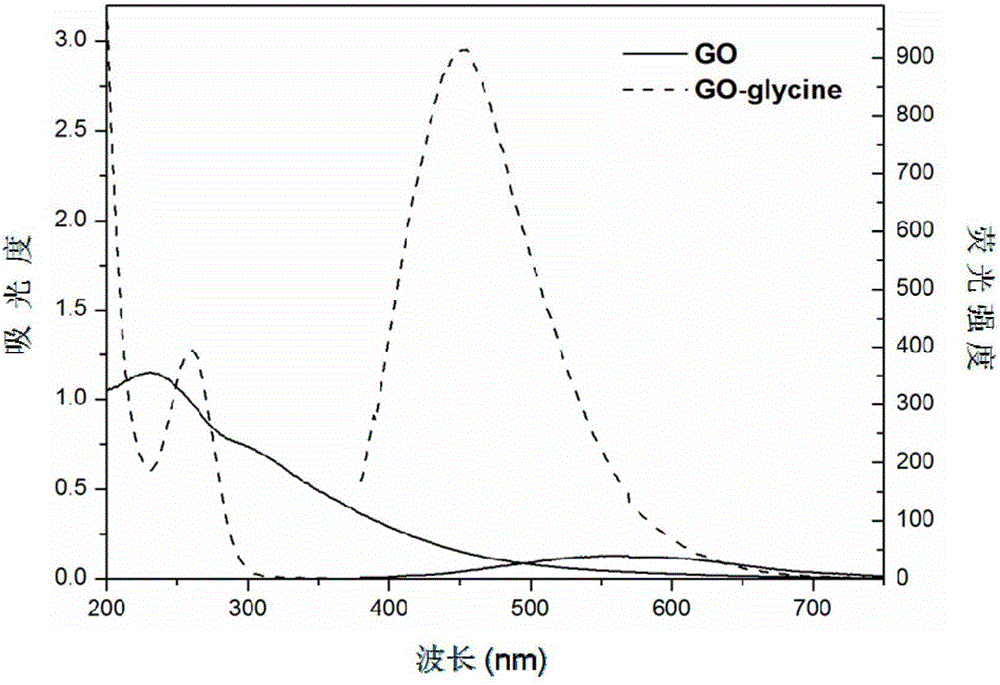Paper sensor for rapid on-site detection of fluorine ions in water and preparation method thereof
A field detection and sensor technology, applied in instruments, measuring devices, scientific instruments, etc., to achieve remarkable effects, stable luminescence properties, and simple operation.
- Summary
- Abstract
- Description
- Claims
- Application Information
AI Technical Summary
Problems solved by technology
Method used
Image
Examples
Embodiment 1
[0039] Embodiment 1, the preparation of paper sensor
[0040] The paper sensor of the present embodiment is based on a filter membrane, and is printed with a membrane-based sensor with evenly distributed fluorescent nanoprobes on the filter membrane; figure 1 As shown, the fluorescent nanoprobe is based on the resonance energy transfer effect, so that the luminescent graphene oxide and silver nanoparticles are specifically combined in the form of boronate bonds through surface functional modification, thereby forming a fluorescent nanoprobe; F - The ions can destroy the specific binding of the borate bond, so that the silver nanoparticles are far away from the luminescent graphene oxide, the fluorescence of the probe system is restored, and the F - ion detection.
[0041] The preparation method of the paper sensor in this embodiment is as follows:
[0042] Step 1, preparation of luminescent graphene oxide:
[0043] (1) Heat 30mL concentrated sulfuric acid to 90°C, add 1g K ...
Embodiment 2
[0062] Embodiment 2, detect F with nanometer fluorescence sensor -
[0063] (1) Add 300 μL of the MPBA-AgNPs solution prepared in Step 4 of Example 1 dropwise to 1 mL of the 3-amino-1,2-propanediol-modified GO-glycine solution (1.0 mg / mL) prepared in Step 3 of Example 1 Add dropwise for 1 h to obtain a nano fluorescent probe solution. 3-Amino-1,2-propanediol-modified GO-glycine was quenched by MPBA-AgNPs to a large extent due to resonance energy transfer. In this embodiment, the fluorescence intensity of the 3-amino-1,2 propanediol-modified GO-glycine solution was measured when the concentration of MPBA-AgNPs was gradually increased. The fluorescence quenching spectra of MPBA-AgNPs added to 3-amino-1,2-propanediol-modified GO-glycine solution are shown in image 3 . It can be seen from the figure that after adding 0.129nM MPBA-AgNPs, the fluorescence of GO-glycine modified by 3-amino-1,2 propanediol was quenched by about 95%, and reached equilibrium, 3-amino-1,2 propanedio...
Embodiment 3
[0068] Embodiment 3, selectivity experiment
[0069] (1) Add 300 μL of the MPBA-AgNPs solution (concentration: 0.129 nM) prepared in Step 4 of Example 1 dropwise to 1 mL of the 3-amino-1,2-propanediol-modified GO-glycine solution prepared in Step 3 of Example 1 (1.0mg / mL) was added dropwise for 1h to obtain a nano fluorescent probe solution. 100 μL of 0.10 M PBS buffer (pH=7.4) was added to the probe solution.
[0070] (2) Add 0.55nM Cl at room temperature and shaking conditions - ,Br - , I - , HCO 3 - ,CH 3 COO - ,CO 3 2- ,HPO 4 2- ,NO 3 - and SO 4 2- Solution, react for 30min;
[0071] (3) Measure the fluorescence of the probe with a fluorescence detector, see the selectivity results Figure 6 , Figure 7 . It can be seen from the figure that among all the anions in the experiment, only fluoride ion can greatly restore the fluorescence of the nano-fluorescent probe, while other anions have almost no effect on the nano-fluorescent probe. Therefore, the nan...
PUM
 Login to View More
Login to View More Abstract
Description
Claims
Application Information
 Login to View More
Login to View More - R&D
- Intellectual Property
- Life Sciences
- Materials
- Tech Scout
- Unparalleled Data Quality
- Higher Quality Content
- 60% Fewer Hallucinations
Browse by: Latest US Patents, China's latest patents, Technical Efficacy Thesaurus, Application Domain, Technology Topic, Popular Technical Reports.
© 2025 PatSnap. All rights reserved.Legal|Privacy policy|Modern Slavery Act Transparency Statement|Sitemap|About US| Contact US: help@patsnap.com



